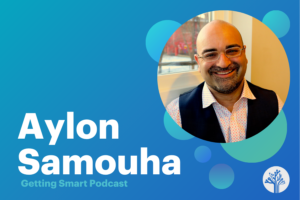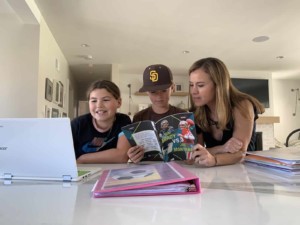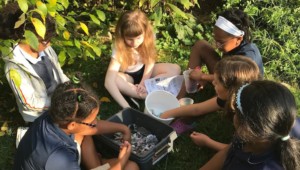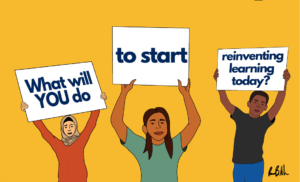Can Learning Be Both Powerful and Boring?

By: David Ross
A couple of weeks ago, I opened the door to my new classroom and faced a line of sixth graders eager to meet their teacher. I don’t know who was more nervous: me or them.
This was my 11th year of teaching, so the nerves should seem out of place. I do have a reasonable excuse. I didn’t take a gap year; I took a gap decade. Years 10 and 11 were separated by a 15-year chasm. As chronicled in an earlier post in this series, I spent those 15 years leading two large and influential educational nonprofits.
On this fine August day, there were a thousand questions swirling in my brain, chief among them was my ability to engage learners in the year 2019. As if to cement that concern, I could hear one of the boys near the back of the line stage whisper to his buddy, “I hope this class isn’t boring.”
I have been called many things over the years, but boring isn’t one of them. I feared, though, that my sojourn in management had dulled my energy or that students had changed and I would come off as the stodgy old man I appeared to be.
Day 1 was the usual blur of forms, rules, confusion, and excitement. But I was worried about that boredom thing. That night, I returned home and did some research on the topic. This is what I learned.
A web search will provide dozens of articles that describe the causes of boredom and its cures, but few spend time defining what the emotion actually comprises. I pivoted my search toward academic research and skimmed abstracts until I found an article entitled “The Unengaged Mind: Defining Boredom in Terms of Attention.” It gives us a definition that describes boredom as we see it in schools: “the aversive experience of wanting, but being unable, to engage in satisfying activity.”
The challenge for teachers, including myself, is to turn learning into a ‘satisfying activity.’
Countless student surveys tell us why learning is not a compelling experience and why students say they are bored. In a piece called Why Kids Get Bored at School – And How to Help, Amanda Morin provides a list of four reasons why students check out:
- They’re not sufficiently challenged.
- They don’t see any incentive.
- They haven’t connected with peers or their teacher.
- Their skills are lacking.
In an article called Bored Out of Their Minds, Zachary Jason used data from Gallup surveys of over 500,000 students to derive a short list of why students are bored:
- An escalating emphasis on standardized tests
- The novelty of school itself fades with each grade
- Lack of motivation
- The transition from the tactile and creative to the cerebral and regimented
I would dispute neither of these lists, mainly because they are in accord with my classroom experiences and with the visits I have made to hundreds of schools in the U.S. and abroad while working at the Partnership for 21st Century Learning and PBLWorks (the Buck Institute for Education).
As you can imagine, I hope to combat these boredom boosters with High Quality Project-Based Learning, the effective integration of technology into instruction, teaching in 15- to 20-minute chunks, and a focus on rigor, relevance and relationships. I am hellbent on creating a new acronym, RtB, or what I cheekily call Response to Boredom.
Bonnie Lathram, writing for Getting Smart a few years ago, put together her recipe for preventing boredom:
- Tell stories
- Create opportunities to be active
- Provide choices
- Allow for students to move at their own pace
- Play
- Connect school to real life
- Connect school to the future
- Do more projects
- Encourage students to own their boredom—and fix it
This last recommendation appeals to me. I told my sons long ago, and repeatedly, that I wasn’t responsible for curing their boredom. I was responsible for equipping them with the skills and decision-making abilities that would enable them to handle boredom. I feel no differently toward my students. I am not an XBox—I am a teacher.
This stance makes me amenable to arguments that point to the subtle benefits of boredom. Peter Toohey, in his book Boredom: A Lively History, argues that “boredom is, in fact, one of our most common and constructive emotions and is an essential part of the human experience.” Toohey devotes attention to the role that boredom plays in culture and how it can serve as a stimulus to art, literature, and innovation.
As I prepare my plans for each week of teaching, I think a lot about Morin’s list—especially her observation that boredom can be caused by a lack of student skill. This is especially troubling to me because I work at a school that is on program improvement and routinely posts test scores that are far below targets. If she is right, I have to create an engaging learning environment while building skills. And some of that work is boring.
It will take me a year of planning, practice, revision, and data collection, but I will report back on my attempts to use engaging strategies such as PBL to improve my students’ skills and knowledge. Boredom will battle engagement for student hearts and minds; let’s see which wins.
For more, see:
- We’ve Got it Backwards: Starting with Content Rather than Learners Doesn’t Work
- Investing in the Art of Teaching
- The Lure of the Classroom
Stay in-the-know with all things innovations in learning by signing up to receive our weekly Smart Update.
David Ross, formerly the Senior Director for the Buck Institute for Education and CEO of the Partnership for 21st Century Learning, continues a monthly series chronicling his decision to go from classroom to boardroom and back again. Read his first post in the series here.








0 Comments
Leave a Comment
Your email address will not be published. All fields are required.